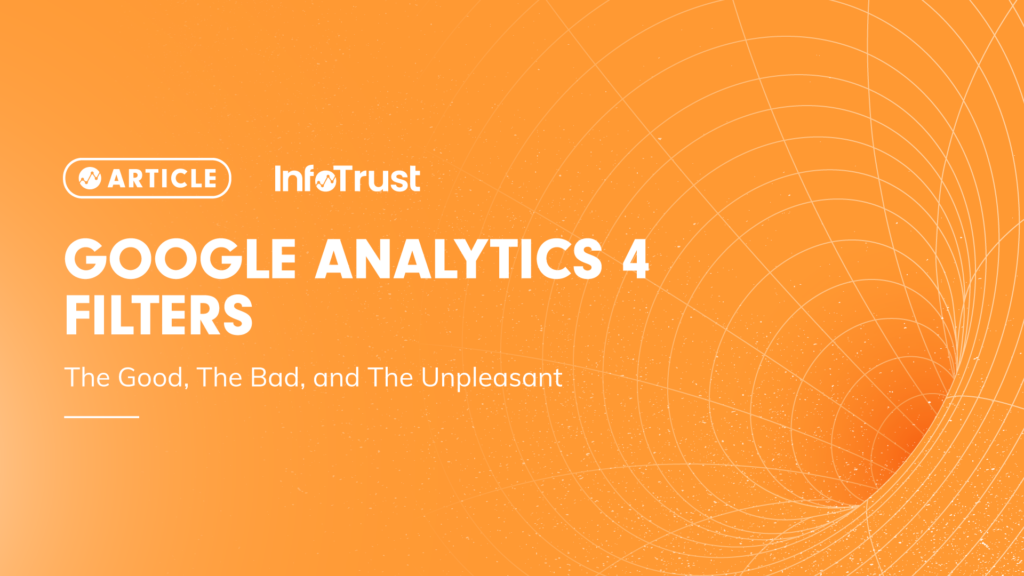Google Analytics 4 (GA4) filtering when compared to Universal Analytics (UA) is clearly more restrictive. Gone are the days of filtering by URL string. Due to the event-based model, GA4 filtering is very minimalistic, currently only permitting the filtering of internal traffic by IP address. Furthermore, IP ranges must be specified by CIDR notation. What filtering was lost in the configuration of properties, however, is now to be found in reporting—namely within the GA4 “Explorer” reports. All this speaks to the new data model of GA4—flat, simple, and scalable, as well as far better suited to report user engagement across domains and platforms—all while respecting user preferences for privacy in the absence of third-party cookies.
The good:
- Bot filters are automatically implemented
- Filters can be tested before implementation
- Filtering easier to manage due to simplicity
The bad:
- Only filtering options are for internal users and developers
- View of “raw” data unavailable
- Filters cannot be shared
The unpleasant:
- Filtering configurations are made for each property’s datastream
- Use of Regex not available for specifying IP ranges
- IP range filtering only available via CIDR notation
Configuring GA4 Filters
Although implemented at the property level, GA4 filters are configured within the datastream component. For each GA4 property datastream, buried within the tag configure settings, configuration may be made—specifying IP address for visits considered “internal”. By default, the internal IP address populates the traffic_type parameter with a value. Several options exist for identifying IP addresses; unfortunately Regex is not an option. IP range identification is now configured making use of CIDR notation. For each datastream, up to 10 filters may be configured and for each filter, 10 fields are available—so there’s plenty of room for designation of internal visitor IP addresses, especially if CIDR (Classless Inter-Domain Routing) notations are used.
What Is CIDR Notation and Why Should I Care?
CIDR notation is a way to efficiently represent ranges of IP addresses. When a range of IP addresses is expressed in CIDR notation, indicated are how many of the bits are fixed and how many can be of any value. Although simple, the paradigm can be tough to grasp for those used to Regex expressions for the configuration of IP ranges. Many CIDR notation generators exist online and can be an extremely useful resource.
Are There Any Other Options to Implement Filtering within GA4?
Google Analytics 360 provides the option of subproperties. The filtering associated with subproperties is subject to the events associated with the source property. Again, reflecting the new event-based model of GA4, subproperties, although providing a filtering method not available in regular GA4 properties, have limitations. InfoTrust does not recommend considering subproperties as a replacement for filtered views found in UA. With Google Analytics 360 subproperties, filters are configured using event parameters. These include event-scoped dimensions such as geography. Unfortunately, user properties cannot be used for filters. Also, there are some automatically generated events that will only have some standard event parameters. Despite these restrictions, some consistently collected attributes may be used when configuring subproperty event-based filters.
What to Consider When Implementing Internal Visitor Filters
Internal filters require not only initial configuration, but also maintaining the list of IP addresses to keep the filters relevant. This important maintenance element must be considered when deploying internal GA4 filters across various properties. For companies where internal visitor activity is of explicit interest, one strategy is to make use of a dedicated GA4 property exclusively filtering on internal visitors and also deploy the GA4 property across all digital properties—albeit at the cost of an additional property. This way only one GA4 property requires configuration and maintenance of internal IP addresses. Reporting for the individual digital properties can be made via filtering by datastream.
Pro tip: Making internal filters “active” will remove this user attribute from your BigQuery data feed. Keeping the internal filters in perpetual “test” mode will allow the users with this internal visitor attribute to be passed via BigQuery for analysis outside of GA4.
Final Thoughts about GA4 Filtering
GA4 continues to rapidly evolve, so filtering enhancements will hopefully be introduced (e.g. use of Regex). However, at this time the only filtering options available are those for internal visitors and developers. The value of filtering out traffic from internal visitors will vary by business and industry. For some companies, valuable intelligence is provided by knowing how employees engage with a public-facing website. Having said this, the effectiveness of internal visitors, however, has increasingly become challenging with more employees working remotely and not making use of a VPN connection. In summary, the configuration, implementation, and maintenance of internal filters will be based on business needs.


